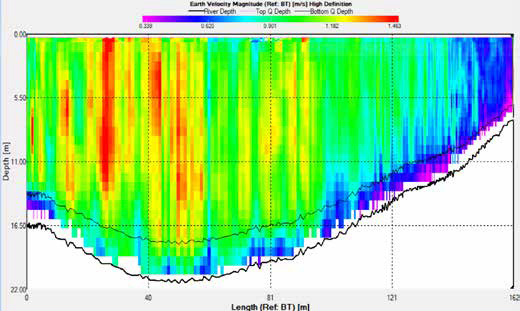Description
River cross-sections are fundamental tools for understanding the physical and hydraulic properties of a river. They are used in a wide range of applications, from flood management and discharge measurement to sediment transport and ecosystem conservation. By providing essential insights into how water flows and interacts with the river channel, these cross-sections help improve river management, infrastructure design, and environmental protection efforts. River surveys using ADCP cross section technology provide accurate and detailed data for these purposes.
An Acoustic Doppler Current Profiler (ADCP) is a modern and advanced tool used in hydrology and river engineering to measure water flow velocity and discharge. When used to collect data across a river, it can produce detailed ADCP cross sections, which are critical for understanding the river’s flow dynamics, its depth, and velocity distribution.
Key Concepts:
-
River Cross-Section: This is a vertical profile of a river channel, showing its shape, depth, and width at a specific location. It is an essential tool for evaluating river hydraulics and is used in flood modeling, sediment transport studies, and water resource management. River surveys rely on accurate cross-section measurements.
-
ADCP (Acoustic Doppler Current Profiler): An ADCP is an instrument that uses sound waves to measure the velocity of water at various depths across the river’s cross-section. By emitting sound pulses and analyzing the frequency shift (Doppler effect) as they bounce off particles in the water, the ADCP can determine water speed and flow direction. This allows the creation of precise ADCP cross sections.
How ADCP Measures River Cross-Sections:
The ADCP provides high-resolution data on the velocity of water at different depths and across the width of the river. The process works as follows:
-
Deployment: The ADCP is typically mounted on a boat or a stationary platform at the river’s surface or on the riverbed. It can also be deployed from the shore or on a bridge.
-
Data Collection: The device emits sound pulses that bounce off particles suspended in the water (like sediment or bubbles). By measuring the frequency shift of the reflected sound waves, the ADCP calculates the velocity of water at various depths across the river’s width.
-
Cross-Section Creation: The ADCP collects data continuously across the river, capturing the speed of the water at different locations. This information is used to create a detailed ADCP cross-sectional profile, which includes:
-
Water Depth: Measured at various points along the river.
-
Velocity Distribution: The flow speed at different depths and across the width of the river.
-
Flow Direction: The direction of water flow, which can vary across the river’s width.
-
-
Post-Processing: The data collected is then processed and integrated into software that creates a visual representation of the river cross-section, showing depth, velocity, and flow characteristics.
Applications of River Cross-Sections Measured by ADCP:
-
Hydraulic Modeling: ADCP-derived cross-sections help in creating hydraulic models to simulate and predict flow conditions under different scenarios, such as flood events or changes in river infrastructure.
-
Discharge Measurement: By combining velocity data with depth measurements, the ADCP allows for the calculation of river discharge, which is the volume of water flowing per unit of time. This is especially useful in river surveys for management and flood forecasting.
-
Sediment Transport Studies: The velocity profiles collected by the ADCP help scientists understand how sediment moves through the river, which is crucial for managing erosion, sediment deposition, and water quality.
-
Floodplain Analysis: Detailed cross-sections are used to evaluate how changes in riverbed morphology, channel shape, or water levels affect the floodplain, helping in flood risk assessment and mitigation planning.
-
Infrastructure Design and Management: Engineers use river cross-sections to design and maintain infrastructure such as bridges, dams, and levees. Understanding the river’s cross-sectional profile helps ensure that structures are built to withstand high flow conditions.
Advantages of Using ADCP for River Cross-Section Measurements:
-
High Precision: ADCPs provide accurate, real-time data on river velocities and depths, which is more precise than traditional methods (e.g., flow gauging stations or manual measurements).
-
Non-Invasive: ADCPs operate without disturbing the river’s flow or sediment, allowing for safer and more reliable measurements, especially in sensitive ecosystems.
-
Efficiency: The technology allows for rapid data collection over large river sections, reducing the time and effort needed compared to traditional methods.
-
Versatility: ADCPs can be used in various river environments, from slow-moving streams to fast-flowing, turbulent rivers, providing valuable data in many different conditions.
Summary:
Incorporating ADCP cross section technology into river surveys offers a powerful, efficient way to measure river dynamics, discharge, and flow velocities. The data collected not only provides a clear snapshot of a river’s physical properties but also supports effective flood management, water resource planning, and environmental protection.



Reviews
There are no reviews yet.